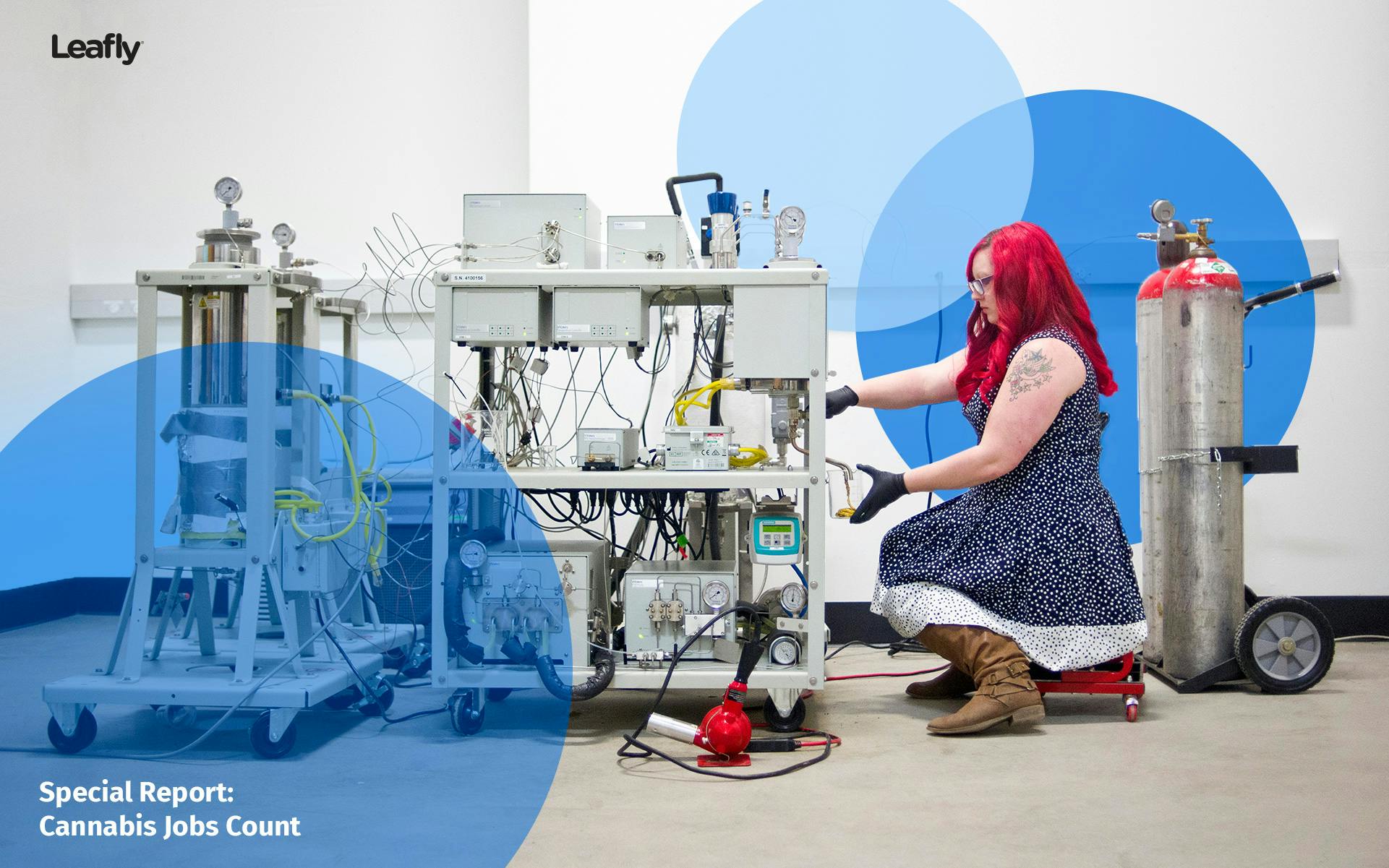How many jobs are there in America’s legal marijuana industry?
Cannabis is America’s fastest-growing industry.
The 2021 Leafly Jobs Report, issued earlier today, found 321,000 full-time equivalent (FTE) jobs supported by legal cannabis as of January 2021. That total includes both plant-touching and ancillary jobs—everyone from budtenders to bean-counters.
To put that in perspective: In the United States there are more legal cannabis workers than electrical engineers. There are more legal cannabis workers than EMTs and paramedics. There are more than twice as many legal cannabis workers as dentists.

The annual Leafly Jobs Report, produced in partnership with Whitney Economics, is the nation’s cornerstone cannabis employment study.
Federal prohibition prevents the US Department of Labor from counting state-legal marijuana jobs. Since 2017, Leafly’s news and data teams have filled that gap with a yearly analysis of employment in the legal cannabis sector.
Whitney Economics, a leading consulting firm that specializes in cannabis economics, policy, and business consulting, has partnered with Leafly on the project since 2019.
Open and download the full Leafly Jobs Report 2021

Twice the job growth as 2019
Cannabis job growth in 2020 represents a doubling of the previous year’s US job growth. In 2019, the cannabis industry added 33,700 new US jobs for a total of 243,700.
Despite a year marked by a global pandemic, spiking unemployment, and economic recession, the legal cannabis industry added 77,300 full-time jobs in the United States in 2020. That represents 32% year-over-year job growth, an astonishing figure in the worst year for US economic growth since World War II.

Cannabis now an $18.3 billion industry in the United States
In 2020, Americans purchased $18.3 billion worth of cannabis products, a 71% increase over 2019.
Cannabis sales were up 71% in 2020, driven by pandemic purchasing and newly legal states coming online.
When the COVID-19 pandemic hit the United States in March, many in the cannabis industry worried about a potential industry-wide shutdown. Instead, governors in most states declared cannabis an essential product. Dispensaries and retail stores responded by offering online ordering, curbside pickup, and delivery as COVID-safe options for their customers.
Customers responded by stocking up for months of stay-at-home advisories and social distancing. After a brief dip in late-March revenue, most stores saw a significant bump in April—and then the bump became a plateau.
Why didn’t hiring match sales increases?
Rising revenue usually drives more hiring, as businesses expand to meet the increased demand. But in 2020 two new factors caused staff hiring to lag significantly behind the revenue climb.
Investors were frightened off by less-than- spectacular returns on Canadian investments at the one-year anniversary of federal legalization up north. That made it harder for US companies to expand and invest in new employees. What little money was available all but vanished in late March 2020, when the COVID pandemic arrived.
The pandemic ultimately drove increased sales industrywide. But social distancing, occupancy limits, and shelter-in-place orders limited the ability of staff members to occupy a public retail space and work closely together.
In some cases, a reverse dynamic came into play. Some booming businesses reported staffing shortages as employees themselves fought off the virus, quarantined due to contact tracing, showed signs of possible infection, or were forced to stay at home due to underlying medical conditions. One business owner reported more staff turnover in 2020 due to the pandemic than in the previous five years.
Black ownership remains a pressing issue
As cannabis continues its run as America’s fastest-growing industry, troubling racial and gender disparities remain.
Black Americans represent 13% of the national population, but they represent only 1.2% to 1.7% of all cannabis company owners—a gap that is far too wide.
This year’s Leafly Jobs Report takes a deeper look into the factors that gave rise to that gap, the barriers that still remain in place, and the promising initiatives opening up opportunities.
Methodology: How we calculate cannabis jobs
The 2021 Jobs Report was created by journalists, editors, and data analysts at Leafly, in partnership with labor economists at Whitney Economics.
Leafly and Whitney Economics examined revenues driven by the legal and adult-use markets, combined labor permit data, inputs for business licenses, regulatory structures, and breakdowns by business sector to develop a model by which each state’s employment could be estimated. Estimates were then reviewed, refined, and adjusted based on industry and operators inputs.
The jobs report combines data from the following sources:
- US Bureau of Labor Statistics: national and state labor statistics, wage data
- US Census Bureau: population and other demographic information
- US Department of Health and Human Services
- State revenue departments: cannabis sales and cannabis tax revenue
- State labor departments: labor data compiled at the state level
- State health departments: medical cannabis patient data
- State and local cannabis regulators: business licensees, cannabis worker permits
Once the data is compiled, Leafly and Whitney Economics analyze job estimates by contacting industry experts, cannabis business owners, and trade association leaders.
This year, trade associations provided keen insights into specific market conditions not available at state and federal governmental levels. Cannabis business executives offered insight into how government regulations, tax policy, investment capital availability, and the COVID-19 pandemic affected their hiring practices in 2020.
Whitney Economics also conducted a nationwide cannabis industry survey. The survey was valuable in triangulating inputs from government and industry and increasing the accuracy of the Jobs Report. The full results of that survey will be published later in 2021.
Additional research provided by Chris Kudialis, Fatma Khaled, and Dave Howard.











